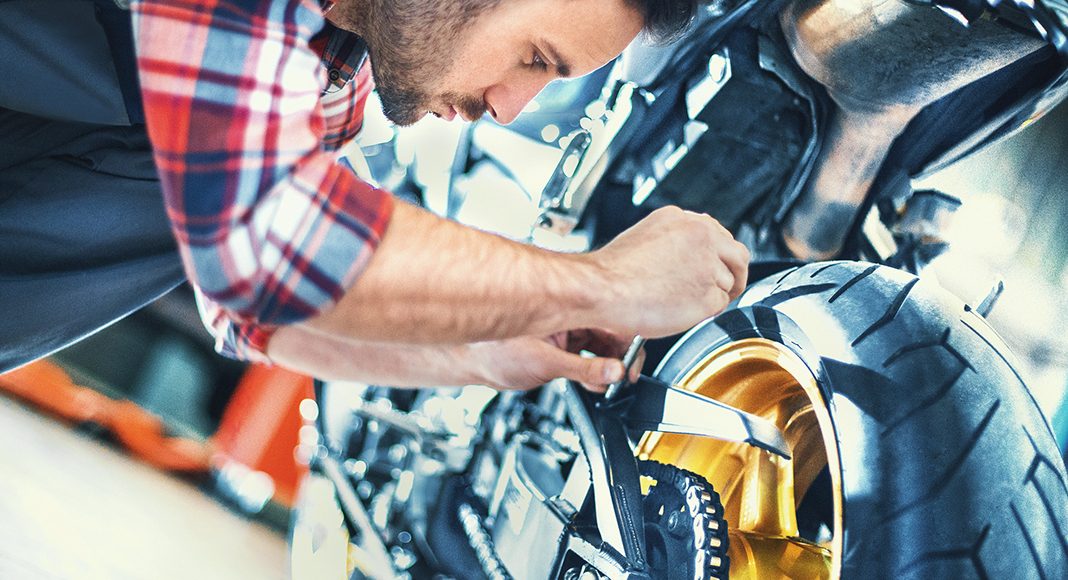Keeping your motorcycle – or two-wheeler – well-maintained helps to prevent breakdowns and reduce repair bills. Most importantly, combining regular maintenance with professional servicing helps to ensure a safe ride, every trip.
The Motorcycle Safety Foundation recommends inspecting your motorcycle before every trip, using the acronym “T-CLOCS” to remember which checks to carry out. T-CLOCS refers to Tires, Controls, Lights, Oil, Chassis and Stands.
Here’s a guide to using T-CLOCS to maintain your two-wheeler:
TIRES & WHEELS
Your tires provide the grip you need for accelerating, braking and cornering. Motorcycle tires are put under great pressure so it’s important to inspect for tread depth, uneven wear and damage. Having the correct tire pressure helps to prevent blowouts, ensure correct handling and improve tire life. That’s why it’s recommended to check tire pressure before every ride.
Check:
- Tires – condition and air pressure
- Wheels – spokes, cast condition, rims, bearings and seals
- Brakes – function and condition
CONTROLS
Motorcycle controls enable you to steer, accelerate, shift and brake correctly. Control checks should include handlebars, levers, pedal, cables, hoses and throttle—inspecting for condition (damage, cracks, fraying, leaks, signs of deterioration), routing of cables and hoses (checking for interference or pulling) and operation.
Check:
- Handlebars – condition
- Levers and pedal – condition and pivots
- Cables – condition and routing
- Hoses – condition and routing
- Throttle – operation
LIGHTS & ELECTRICS
The lights and electrics on a motorcycle can suffer from wear and tear as the wiring is more exposed than on a car. It’s important that lights are in working order as they help other road users to see you.
Check:
- Battery – condition and vent tube
- Headlamp – condition and aim
- Tail lamp/ brake lamp – condition and operation
- Turn signals – operation
- Switches – operation
- Mirrors – condition and aim
- Lenses and reflectors – condition
- Wiring – condition and routing
OIL & FLUIDS
The fluids in your motorcycle are important; they help to ensure your bike runs smoothly and remains cool. Your owner’s manual will inform you of the correct fluid levels and schedule for changing fluids.
Check:
- Engine oil
- Gear oil, shaft drive
- Hydraulic fluid
- Coolant
- Fuel
CHASSIS
The engine and suspension are mounted to your motorcycle’s chassis. It’s important to check all of the parts; your owner’s manual will explain how to do this. It might be necessary to consult a professional for some of the checks.
Check:
- Frame – condition, steering-head bearings, swingarm bushings
- Suspension – front forks, rear shocks
- Chain or belt – tension, lubrication, sprockets
- Fasteners – threaded, clips & cotter pins
STANDS
Some motorcycles have only a side stand; some have both a side stand and center stand. It’s recommended that you look for cracks or bends in the stands to ensure they can do their job and keep your motorcycle upright when in use.
Check:
- Center stand and side stand for condition and retention
Watch the Motorcycle Safety Foundation’s video explaining how to carry out the T-CLOCS checks.
Download the Motorcycle Safety Foundation’s T-CLOCS inspection checklist which includes further information about the checks listed above.
Remember: T-CLOCS is a great tool for basic motorcycle inspection, but your motorcycle owner’s manual is the best source of information specific to maintaining your motorcycle.
eDriving also has tips for two-wheeler riders on helmets and safety wear and carrying passengers and loads.



















